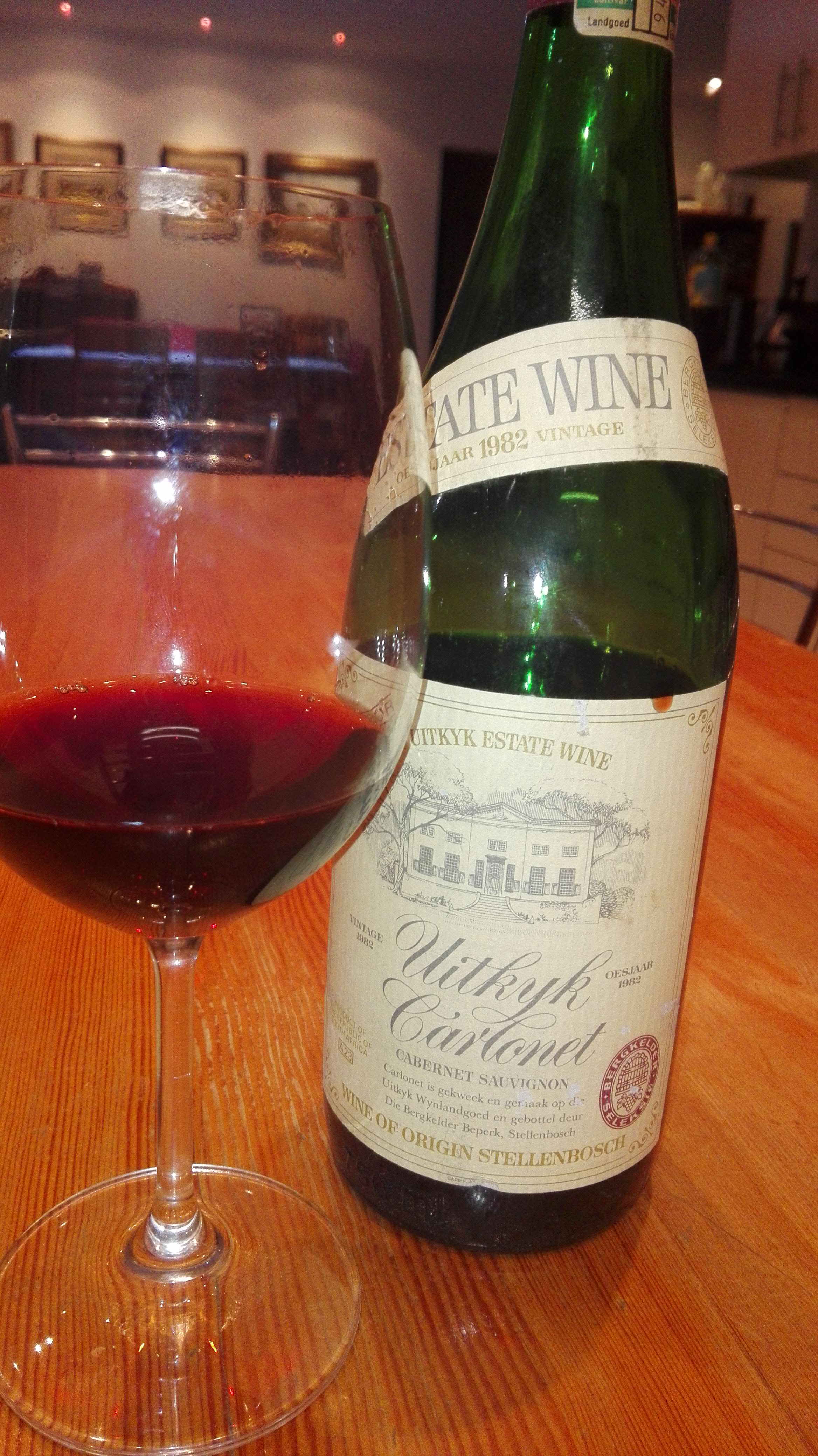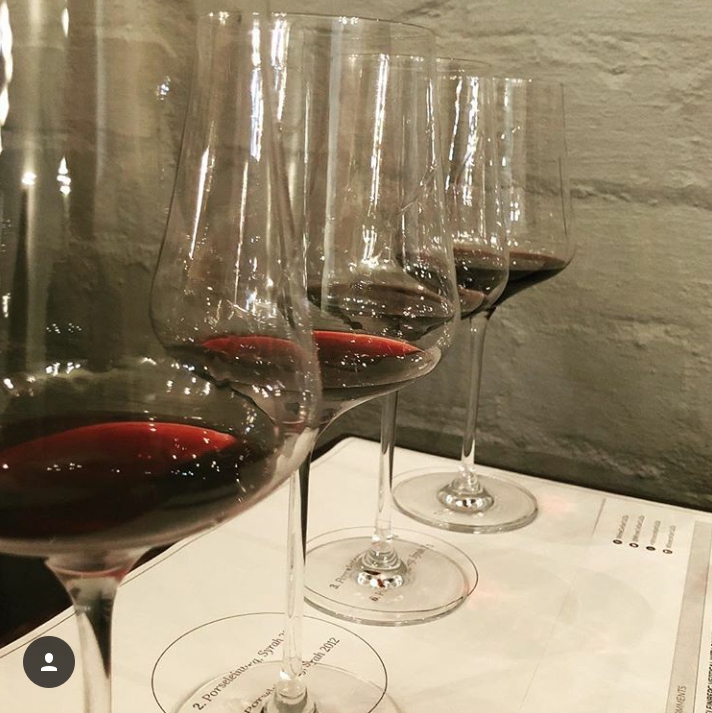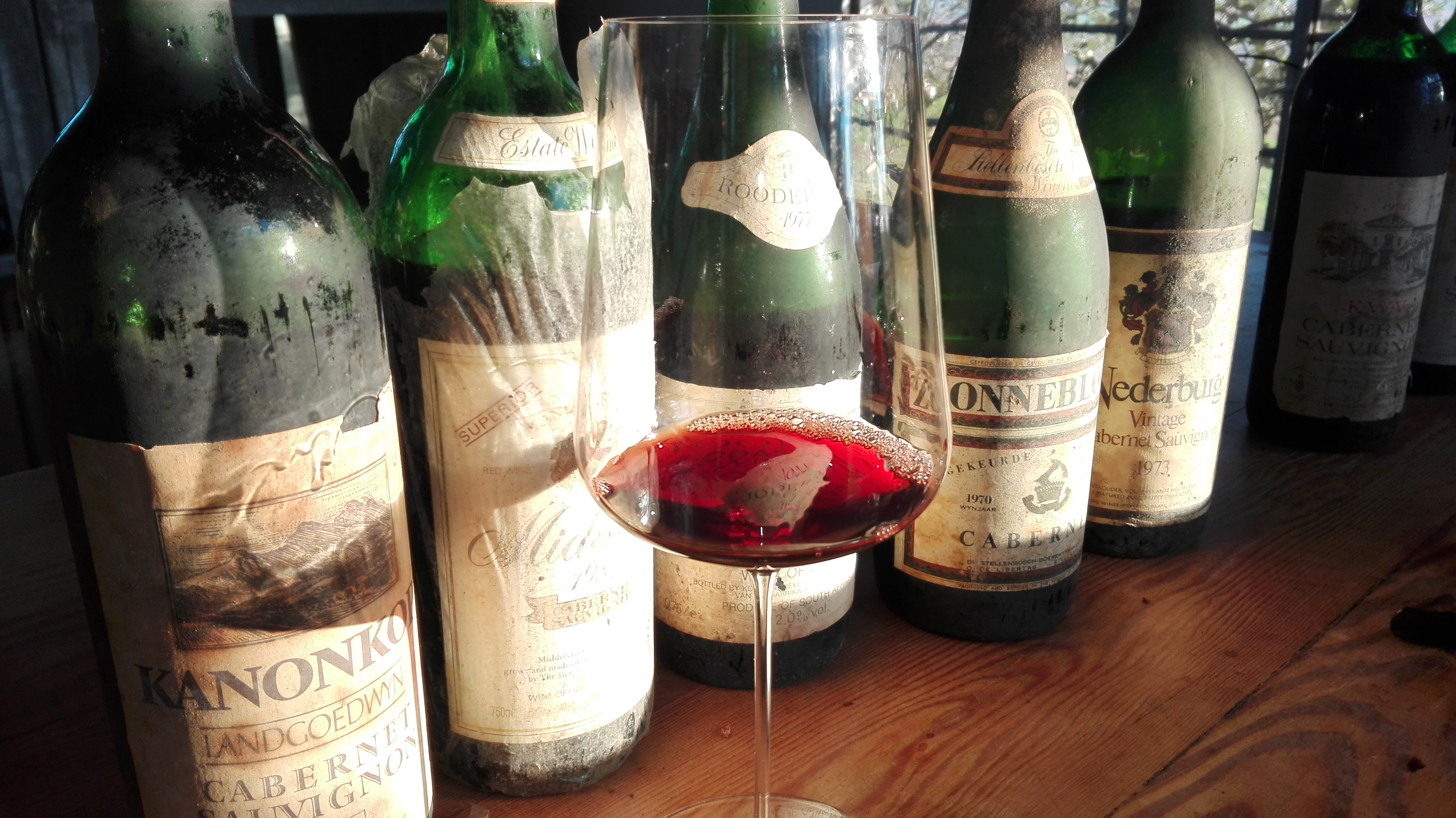Over the weekend I was part of a tasting of 22 wines offered by Harald Bresselschmidt owner of the collection based at his Auslese Cellar. The line up spanned nearly every decade from 1934 to 2020. Although there was many incredible wines in the line-up the 4 oldest wines completely shot the lights out!
1962 “GS” Cabernet Sauvignon (Andre Simon Memorial Dinner)

Romi van der Merwe wrote that there had been 3 vintages of George Spies’s wine, namely a 1962, 1966 and 1968. It is rumored that the 1962 bottle of Cabernet custom labelled for an “Andre Simon memorial dinner” was in fact a George Spies wine. I reported previously about the Guild tasting held at Spier in 2016 where a 1962 was opened (https://sawinebooks.wordpress.com/2019/08/29/george-spies-1962/). Getting to taste it for myself was therefore very important. At first sniff it was unmistakably GS! On 3 occasions before have I tasted the 1966 and is familiar with a particular aroma it carries. For me there is an unmistakable and very specific smell on the GS. I immediately picked it up on this bottle. It was just again confirmation that we are indeed dealing here with George Spies’s Cabernet. What followed from the nose on to the palate was even more remarkable; it had the same purity and precision of the 1966 but it was even finer! It is slightly less dense than the 66 and incredibly clean. It is said that the wine got no wood treatment and mindful of how clean and precise it is I am convinced that this was very well the case. This is brilliant winemaking! There is only one way to describe it: Space-Age!
1949 Hazendal Cabernet

This bottle came from the late Harold Zeh’s collection. About a year ago Pieter de Waal (Hermit on the Hill wines) opened a bottle given to him by Mr Zeh. According to Pieter at least one other bottle from the same source was also tasted recently. It does not carry a vintage date, and our host thought that it was from the 1959 vintage. However Pieter was kind enough to provide me with email correspondence from Mr Zeh confirming it was a 1949 (see email below). At Pieter de Waal’s event the wine showed so well that it was thought better than a 1966 GS tasted alongside it! For me it had the most incredible mocha/toffee/caramel nose and the color was eager and alive! A delight!
Analysis (date tested: 12 Nov 2020):
13.73% alc. – 1.59 g/L RS – 3.73 pH – 5.68 g/L TA
Harold Zeh’s email to Pieter de Waal (2014):
Hi Pieter,
Sorry to answer so late. We are travelling in Europe and now are enjoying drinking Chasselas in Switzerland.
In answer to your question I can tell you that the wine was marketed many years ago when I was still a teenager by a company called FEDERAL WINE AND BRANDY COMPANY.
Their offices were in a building , coming from Paarl, on the left, at the turn-off to Nederburg. This building still exists.
The company was owned by 2 brothers but I only remember the name HAROLD KRAMER because I used to go there with my father.
They bought the wine from Hazendal and marketed it. The vintage is 1949. It was great hearing your history.
Thank you.
Regards
Harold Zeh
1934 Groot Constantia Cabernet

A 1934! Who would have thought! and what to expect?, and it did not disappoint. On the nose it showed slight “nail polish” which did not detract but was rather part of the wines story (you have to be kind to an 86 year old!). Again a beautifully full, smooth and harmonious wine. Incredible that a wine this old could still be so intact.
Analysis (date tested: 12 Nov 2020):
13.50% alc. – 1.59 g/L RS – 3.81 pH – 5.34 g/L TA.
Tim James reported that Groot Constantia was possibly the first to plant Cabernet Sauvignon at the Cape. The story can be found here: https://winemag.co.za/wine/opinion/tim-james-the-story-of-cabernet-in-the-cape/
1960s Schoongezicht Frontignac

This bottle came from the Overgaauw cellar and according to Tammy Barlow of Rustenberg dates from around the 1960s. The Muscat flavors jumped right out of the glass showing remarkably primary with little development! I thought this was really incredible for such an old sweet wine. There is an interesting note on the wine found in Kenneth Maxwell’s “Fairest Vineyards” (1966) that reads:
..produced exclusively from Muscat de Frontignan grapes which are almost the only vines of this type still growing in the Cape and descended from the vines which made the old Sweet Constantia famous in the 18th Century.
(I will leave it to the imagination of the reader but bear in mind that one of the Cloetes of Groot Constantia once was the owner of Schoongezicht….)
Conclusion
What struck me the most was how confident the wines were; it made the 70s and 80s wines look small in comparison! They show a sturdy, dense style with roundness and no awkward acidity found so often on wines of the preceding decades. A triumph of old Cape viti- and viniculture!
H O Taljaard
Complete list of wine tasted:
Paarl Sherry Fine and Rare (ca.1950’)
2020 Sadie Family White Palladius 2020, Naudé ‘Langpad’ Colombard
2012 Palladius, Boekenhoutskloof Semillon 2011
2005 Rudera Chenin Robusto, 2004 Vergelegen CWG The White, Hamilton Russel Vineyards Chardonnay 2002, 2000 Sadie family Palladius “Red”
1995 Meerlust Pinot Noir, Warwick Cabernet Franc 95, Warwick Cabernet Sauvignon 94
1980 Meerlust Cabernet Sauvignon, 82 Kanonkop Cabernet Sauvignon, 84 Stellenryck Cabernet Sauvignon
1976 Stellenryck Pinotage, 76 Delheim Pinotage, 73 KWV Cinsault, 78 Nederburg Shiraz
1962 GS Cabernet Sauvignon ‚International Wine & Food Society‘, 1968 Chateau Libertas
1949 Hazendal Cabernet,
1934 Groot Constantia Cabernet Sauvignon
1980 KWV Nobel Late Harvest, 1960s Schoongezicht Frontignac
1949 Deinhard & Co Liebfraumilch Riesling,
Analysis of some of the older wines:
Cape Town, 7th of November 2020









